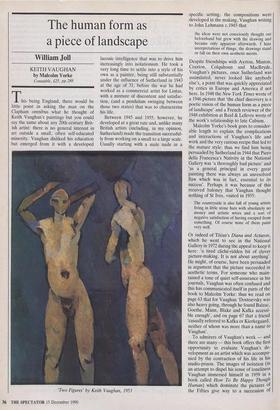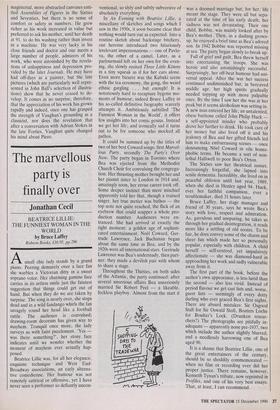The human form as a piece of landscape
William Jo11
KEITH VAUGHAN by Malcolm Yorke Constable, £25, pp.288 This being England, there would be little point in asking the man on the Clapham omnibus what he thought of Keith Vaughan's paintings but you could say the same about any 20th-century Brit- ish artist: there is no general interest in art outside a small, often self-educated minority. Vaughan disliked his education but emerged from it with a developed laconic intelligence that was to drive him increasingly into isolationism. He took a very long time to settle into a style of his own as a painter, being still substantially under the influence of Sutherland in 1943 at the age of 31; before the war he had worked as a commercial artist for Lintas, with a mixture of discontent and satisfac- tion, (and a pendulum swinging between those two states) that was to characterise his life.
Between 1945 and 1955, however, he developed at a great rate and, unlike many British artists (including, in my opinion, Sutherland) made the transition successful- ly from working on a small to a large scale. Usually starting with a male nude in a 'Two Figures' by Keith Vaughan, 1953 specific setting, the compositions were developed in the making, Vaughan writing to John Lehmann c.1945 that the ideas were not consciously thought out beforehand but grew with the drawing and became only apparent afterwards. I hate interpretations of things, the drawings stand or fall on their own aesthetic merits.
Despite friendships with Ayrton, Minton, Craxton, Colquhoun and MacBryde, Vaughan's pictures, once Sutherland was assimilated, never looked like anybody else's, a point that was quickly appreciated by critics in Europe and America if not here. In 1948 the New York Times wrote of a 1946 picture that 'the chief discovery is a poetic vision of the human form as a piece of landscape' and a French reviewer of the 1948 exhibition at Reid & Lefevre wrote of the work's relationship to late Cubism.
Malcolm Yorke's book goes to consider- able length to explain the complications and interactions of Vaughan's life and work and the very curious recipe that led to the mature style: thus we find him being persuaded by Sutherland in 1944 that Piero della Francesca's Nativity in the National Gallery was 'a thoroughly bad picture' and 'as a general principal in every great painting there was always an unresolved flaw which was in fact, essential to its success'. Perhaps it was because of this received baloney that Vaughan thought nothing of St Ives, visited in 1955: The countryside is also full of young artists. living in little stone huts with absolutely no money and artistic wives and a sort of negative satisfaction of having escaped from something. Of course none of them paint very well.
Or indeed of Titian's Diana and Actaeon, which he went to see in the National Gallery in 1972 during the appeal to keep it here: 'a tired cliche-ridden bit of clever picture-making. It is not about anything'. He might, of course, have been persuaded in argument that the picture succeeded in aesthetic terms. For someone who main- tained a tone of quiet self-assurance in his journals, Vaughan was often confused and this has communicated itself in parts of the book to Malcolm Yorke: thus we read on page 63 that for Vaughan `Dostoevsky was also heavy going, through he found Balzac, Goethe, Mann, Blake and Kaflca accessi- ble enough', and on page 67 that a friend 'casually referred to Kafka or ICierkegaard, neither of whom was more than a name to Vaughan'. To admirers of Vaughan's work — and there are many — this book offers the first opportunity to evaluate Vaughan's de- velopment as an artist which was accompa- nied by the contraction of his life in his studio-prison. The images of isolation On an attempt to dispel his sense of loneliness Vaughan immersed himself in 1959 in a book called How To Be Happy Though Human) which dominate the pictures of the Fifties give way to a succession of
magisterial, more abstracted canvases enti- tled Assemblies of Figures in the Sixties and Seventies, but there is no sense of comfort or safety in numbers. He grew richer as his work increased in value but preferred to ask his mother, until her death at 91, to do his washing rather than invest in a machine. He was very lucky in his close friends and doctor and one meets a large number of people, admirers of his work, who were astonished by the revela- tions of unhappiness and depression pro- vided by the later Journals. He may have had off-days as a painter, but the late pictures (which are particularly well repre- sented in John Ball's selection of illustra- tions) show that he never ceased to de- velop. It comes as no surprise, therefore, that the appreciation of his work has grown rapidly and indeed, once one has grasped the strength of Vaughan's grounding as a classicist, nor does the revelation that after a conversation with Adrian Stokes in the late Forties, Vaughan quite changed his mind about Piero.



























































 Previous page
Previous page